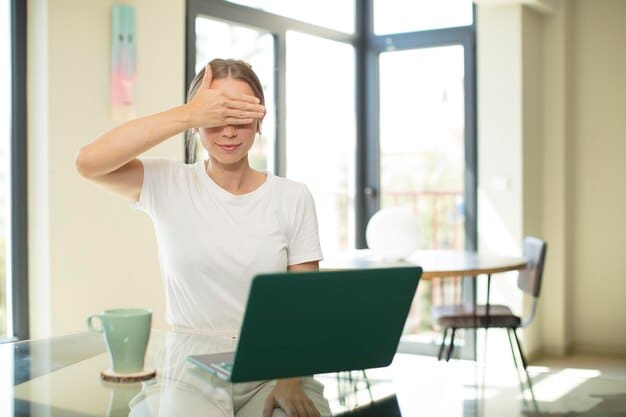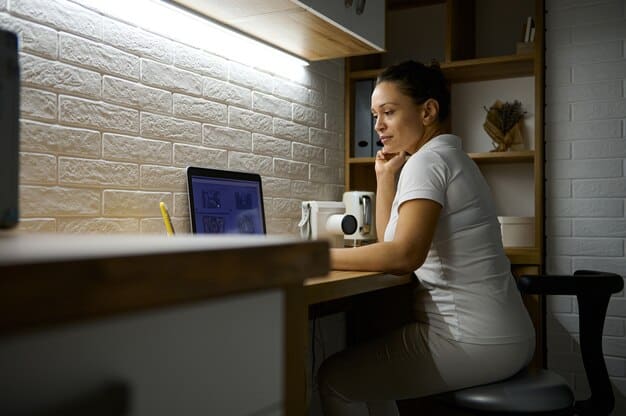Reduce Eye Strain: 5 Tips for Protecting Your Eyes

Reduce eye strain in the digital age by adopting simple habits like the 20-20-20 rule, optimizing your screen settings, and ensuring proper lighting, all contributing to healthier vision and increased comfort.
In today’s digital world, where screens dominate our lives, reduce eye strain: 5 tips for protecting your eyes in the digital age has become more critical than ever. Prolonged exposure to digital devices can lead to discomfort, blurred vision, and even long-term vision problems. But, with a few simple adjustments to your daily routine, you can easily protect your eyes and maintain comfortable vision.
Understanding Digital Eye Strain
Digital eye strain, also known as computer vision syndrome, is a common condition resulting from prolonged use of electronic devices. It manifests through various symptoms, making it crucial to understand its causes and effects.
Several factors contribute to digital eye strain, impacting overall eye health and comfort.
Causes of Digital Eye Strain
The primary causes of digital eye strain are related to how we interact with screens and the environment around us. Understanding these causes can help in adopting preventive measures.
- Prolonged Screen Time: Spending hours looking at screens without breaks can tire the eye muscles.
- Poor Lighting: Glare from screens in poorly lit rooms can cause discomfort.
- Incorrect Viewing Distance: Sitting too close or too far from the screen can strain the eyes.
- Uncorrected Vision Problems: Underlying vision issues can exacerbate the symptoms of digital eye strain.
Symptoms of Digital Eye Strain
Recognizing the symptoms of digital eye strain is the first step in addressing the issue. Early detection can prevent the condition from worsening.
Common symptoms include:
- Eye Fatigue: Feeling tired or heavy eyelids.
- Blurred Vision: Difficulty focusing on objects.
- Dry Eyes: A gritty or burning sensation.
- Headaches: Tension headaches caused by eye strain.
Digital eye strain is a prevalent issue in our tech-heavy world, but knowing its causes and symptoms is essential to tackling it effectively. By understanding what leads to this syndrome and how it manifests, we can actively take steps to alleviate and prevent it.
The 20-20-20 Rule: A Simple Solution
The 20-20-20 rule is a straightforward yet highly effective method to combat eye strain. It’s easy to remember and can be seamlessly integrated into your daily routine.
Here’s how the 20-20-20 rule works:
For every 20 minutes of screen time you spend, take a 20-second break to look at something 20 feet away. This simple exercise gives your eye muscles a chance to relax, reducing strain and fatigue.
Implementing the 20-20-20 Rule
To make the 20-20-20 rule a consistent part of your day, consider setting alarms or using apps. These tools can remind you to take regular breaks, ensuring you adhere to the rule.
- Set Alarms: Use your phone or computer to set reminders every 20 minutes.
- Use Apps: Eye-care apps can track your screen time and prompt you to take breaks.
- Make it a Habit: Incorporate the rule into your workflow, making it a natural part of your day.
Benefits of the 20-20-20 Rule
The 20-20-20 rule provides numerous benefits for your eyes, including:
- Reducing Eye Fatigue: By allowing your eye muscles to relax, you can prevent fatigue.
- Preventing Dry Eyes: Regular breaks can help maintain moisture in your eyes.
- Improving Focus: Short breaks can enhance your ability to concentrate when you return to the screen.
The 20-20-20 rule is a simple and effective way to reduce eye strain: 5 tips for protecting your eyes in the digital age. Consistently following this rule can lead to significant improvements in your overall eye comfort and vision health.

Optimize Your Screen Settings
Adjusting your screen settings can significantly reduce eye strain. Proper brightness, contrast, and text size can minimize the effort your eyes need to focus and process information.
Optimal screen settings include brightness adjusted to match your surroundings, comfortable contrast levels, and readable text sizes. These adjustments help reduce eye fatigue.
Adjusting Brightness and Contrast
Brightness and contrast are key factors in reducing eye strain. Adjusting these settings to match your environment can make a big difference.
Here’s how to adjust these settings:
- Brightness: Adjust the brightness to match the ambient light. Too bright or too dim can strain your eyes.
- Contrast: Set the contrast for comfortable viewing. High contrast can be harsh, while low contrast can be difficult to read.
Adjusting Text Size and Font
Reading small or difficult-to-read text can cause eye strain. Adjusting the text size and font can improve readability.
Consider these adjustments:
- Text Size: Increase the text size to a comfortable level, reducing the need to strain your eyes.
- Font: Choose a clear and readable font. Avoid overly stylized or decorative fonts.
Using Blue Light Filters
Blue light emitted from screens can disrupt sleep patterns and contribute to eye strain. Using blue light filters can mitigate these effects.
Blue light filters can be found in:
- Software: Many devices have built-in blue light filters.
- Apps: Third-party apps can filter blue light on your devices.
- Glasses: Special lenses can block blue light.
Optimizing your screen settings is an essential step in the quest to reduce eye strain: 5 tips for protecting your eyes in the digital age. By adjusting brightness, contrast, text size, and filtering blue light, you can greatly enhance your visual comfort.
Ensure Proper Lighting
Adequate lighting plays a crucial role in reducing eye strain. Poor lighting conditions can force your eyes to work harder, leading to fatigue and discomfort.
Proper lighting involves balancing the light in your environment to minimize glare and shadows. This helps your eyes focus without unnecessary strain.
Minimize Glare
Glare is a major contributor to eye strain. Reducing glare from screens and surrounding surfaces can significantly improve visual comfort.
Practical ways to reduce glare:
- Position Your Screen: Angle your screen away from windows and direct light sources.
- Use Anti-Glare Screens: Apply anti-glare filters to your screens.
- Adjust Room Lighting: Use lamps and shades to control the amount of light in the room.
Optimize Ambient Lighting
The lighting in your environment should be balanced and diffused. Avoid harsh, direct light that can cause shadows and strain the eyes.
Enhance ambient lighting with:
- Indirect Lighting: Use lamps that diffuse light across the room.
- Adjustable Lighting: Use lamps with adjustable brightness settings.
- Natural Light: Maximize natural light where possible, but avoid direct sunlight on your screen.
Avoid Overly Bright or Dim Rooms
Extreme lighting conditions can cause eye strain. Finding the right balance is essential for comfortable vision.
The proper balance involves:
- Reducing Brightness: In overly bright rooms, use curtains or blinds to dim the light.
- Increasing Brightness: Add lamps or overhead lighting in dim rooms to improve visibility.
Ensuring proper lighting is a vital component of the strategy to reduce eye strain: 5 tips for protecting your eyes in the digital age. By minimizing glare and optimizing ambient lighting, you can create a visual environment that supports comfortable and strain-free vision.

Practice Regular Eye Exercises
Just like any other muscle in your body, your eye muscles benefit from regular exercise. Practicing eye exercises can improve focus, reduce strain, and enhance overall eye health.
Regular eye exercises help to strengthen your eye muscles, improve flexibility, and alleviate tension. These exercises are easy to incorporate into your daily routine.
Focus Shifting
Focus shifting involves changing your focus between near and far objects. This exercise helps improve your eyes’ ability to adjust.
Step-by-step guide:
- Look Far Away: Focus on an object in the distance for a few seconds.
- Look Up Close: Then, focus on an object nearby.
- Repeat: Repeat this exercise several times.
Eye Blinking
Blinking helps to keep your eyes lubricated and prevents dryness. Consciously increasing your blinking rate can reduce eye strain.
How to practice blinking:
- Blink Frequently: Make an effort to blink more often during screen time.
- Close Your Eyes: Occasionally close your eyes for a few seconds to help refresh them.
Eye Rolling
Eye rolling can help relax the eye muscles and relieve tension. This exercise is particularly useful after long periods of screen time.
Simple steps for eye rolling:
- Look Up: Roll your eyes in a circular motion.
- Change Direction: Roll your eyes in the opposite direction.
- Repeat: Repeat this exercise several times.
Incorporating regular eye exercises into your routine is a proactive approach to reduce eye strain: 5 tips for protecting your eyes in the digital age. By practicing focus shifting, eye blinking, and eye rolling, you can maintain healthy and comfortable vision.
Maintain Good Posture and Ergonomics
Proper posture and ergonomics are crucial for reducing eye strain and overall physical comfort. Poor posture can exacerbate eye strain by affecting how your eyes focus and align.
Good posture and ergonomic practices involve setting up your workspace to support your body and reduce strain on your eyes, neck, and back.
Position Your Monitor Correctly
The position of your monitor can greatly affect eye strain. Correct monitor placement can reduce excessive neck and eye movement.
Optimal monitor positioning:
- Eye Level: Position the top of your monitor at or slightly below eye level.
- Arm’s Length: Keep the monitor an arm’s length away from your face.
- Tilt: Tilt the monitor slightly upward to reduce glare.
Use an Ergonomic Chair
An ergonomic chair provides proper support for your back and neck, promoting good posture and reducing strain on your eyes.
Key features of an ergonomic chair:
- Adjustable Height: Adjust the chair height to allow your feet to rest flat on the floor.
- Lumbar Support: Ensure the chair has good lumbar support to maintain the natural curve of your spine.
- Armrests: Use armrests to support your arms and reduce shoulder strain.
Take Regular Breaks to Stretch
Taking regular breaks to stretch can help prevent stiffness and reduce eye strain. Simple stretches can relieve tension in your neck, back, and eyes.
Effective stretching exercises:
- Neck Stretches: Gently tilt your head from side to side and forward and backward.
- Shoulder Rolls: Roll your shoulders forward and backward to release tension.
- Eye Stretches: Look up, down, left, and right, holding each position for a few seconds.
Maintaining good posture and ergonomics is a comprehensive strategy to reduce eye strain: 5 tips for protecting your eyes in the digital age. By positioning your monitor correctly, using an ergonomic chair, and taking regular breaks to stretch, you can create a comfortable workspace that supports your vision and overall health.
| Key Point | Brief Description |
|---|---|
| ⏱️ 20-20-20 Rule | Every 20 minutes, look 20 feet away for 20 seconds. |
| 🔆 Screen Settings | Adjust brightness, contrast, and text size for comfort. |
| 💡 Proper Lighting | Minimize glare and optimize ambient lighting. |
| 💪 Ergonomics | Maintain good posture and proper monitor placement. |
Frequently Asked Questions
▼
Digital eye strain, also known as computer vision syndrome, is a group of eye and vision-related problems that result from prolonged use of digital devices, such as computers and smartphones.
▼
The 20-20-20 rule helps to reduce eye strain by giving your eye muscles a chance to relax. Looking at something 20 feet away for 20 seconds every 20 minutes can alleviate fatigue.
▼
Proper lighting reduces eye strain by minimizing glare and shadows, allowing your eyes to focus more comfortably. It prevents your eyes from working harder to compensate for poor lighting conditions.
▼
Yes, eye exercises can improve focus and reduce strain by strengthening eye muscles. Regular practice can enhance overall eye health and alleviate tension after long periods of screen time.
▼
The best posture involves positioning your monitor at or slightly below eye level, maintaining an arm’s length distance, and using an ergonomic chair to support your back and neck, minimizing eye strain.
Conclusion
In conclusion, safeguarding your eyes in the digital age requires a multifaceted approach. By integrating the 20-20-20 rule, optimizing screen settings, ensuring proper lighting, practicing regular eye exercises, and maintaining good posture, you can significantly reduce eye strain and promote long-term eye health. Make these adjustments a consistent part of your daily routine to enjoy comfortable and clear vision.





